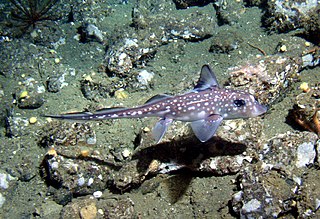
Chimaeras are cartilaginous fish in the order Chimaeriformes, known informally as ghost sharks, rat fish, spookfish, or rabbit fish; the last three names are not to be confused with rattails, Opisthoproctidae, or Siganidae, respectively.

Pycnodus is an extinct genus of ray-finned fish from the Eocene period. It is wastebasket taxon, although many fossils from Jurassic or Cretaceous are assigned to this genus, only Eocene species, P. apodus is valid. As its name suggests, it is the type genus of Pycnodontiformes.
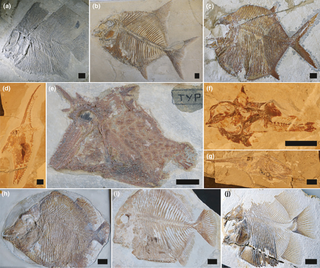
Pycnodontiformes is an extinct order of primarily marine bony fish. The group first appeared during the Late Triassic and disappeared during the Eocene. The group has been found in rock formations in Africa, Asia, Europe, North and South America.
Aphnelepis is an extinct genus of prehistoric freshwater ray-finned fish that lived during the Late Jurassic epoch. It contains a single species, A. australis, from the Talbragar River beds of New South Wales, Australia.

Euthynotus is an extinct genus of prehistoric bony fish that lived during the early Toarcian stage of the Early Jurassic epoch. It is generally considered the basalmost pachycormiform.

Ainia is an extinct genus of prehistoric ray-finned fish that lived during the Kimmeridgian stage of the Late Jurassic epoch. It contains a single species, A. armata, known from the famous Solnhofen Limestone of Germany. It is a distant relative of the bowfin, although it is more closely related to genera such as Caturus and Osteorachis.
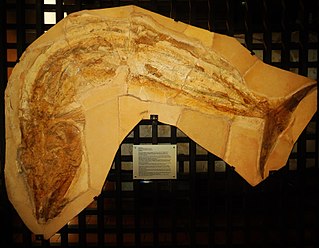
Asthenocormus is an extinct genus of large marine pachycormiform ray-finned fish. It contains a single species, A. titanius. A member of the edentulous suspension feeding clade within the Pachycormiformes, fossils have been found in the Upper Jurassic plattenkalks of Bavaria, Germany.
Euporosteus is an extinct genus of prehistoric sarcopterygian or lobe-finned fish.
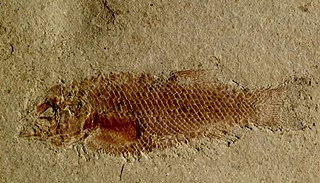
Acentrophorus is an extinct genus of prehistoric freshwater and marine ray-finned fish from the Roadian to the Wuchiapingian of England, Germany (Kupferschiefer), Italy and Russia. There may also be a Triassic occurrence in Australia.
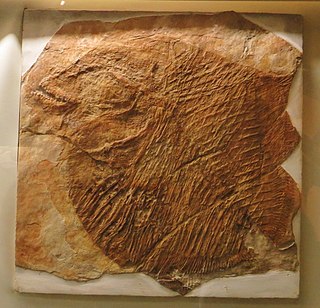
Coelodus is an extinct genus of marine and possibly freshwater pycnodont fish. It contains only one definitive species, C. saturnusHeckel, 1854, from the Late Cretaceous of Slovenia. Other species from the Late Jurassic to the Eocene have also been attributed to this genus based on isolated dental elements, but their assignment to Coelodus is uncertain, and this genus likely represents a non-monophyletic wastebasket taxon. A potential diagnostic trait is a prearticular tooth row with three regular highly elongated teeth.

Coccolepis is an extinct genus of prehistoric marine ray-finned fish in the family Coccolepididae. Originally including most species within the family, it is now restricted to two species from the Late Jurassic Solnhofen Limestone of Germany. The holotype of C. bucklandi, designated and described by Louis Agassiz, was thought to be lost but was later rediscovered in Neuchâtel.

Cylindracanthus is an extinct, enigmatic genus of marine ray-finned fish with fossils known throughout North America, Europe, Asia and Africa from the Late Cretaceous to the late Eocene, with potential Oligocene records and a possible Miocene record also known. It is exclusively known from its distinctive partial remains, which are long cylindrical bony spines that are usually considered rostrum fragments, as well as some associated teeth. These spines are abundant & widespread throughout this timespan, and are useful indicators of a nearshore marine environment, but the taxonomic identity of the fish is still highly uncertain and debated.

Hulettia is an extinct genus of ray-finned fish known from United States. This fish genus contains two species, H. americana and H. hawesi.

Hemicalypterus is an extinct genus of prehistoric ray-finned fish that lived during the late Triassic period. It contains a single species, Hemicalypterus weiri. Fossils have been collected in the southwestern United States, including Utah and New Mexico. Hemicalypterus belonged to the family Dapediidae, and like other members of its family, it was a deep-bodied fish with a covering of thick ganoid scales. It differed from other dapediids in lacking scales on the posterior part of the body, and in possessing unusual, multicuspid teeth. These teeth were similar to those of modern-day herbivorous fish, which indicates that Hemicalypterus may have been a herbivore as well.

Proscinetes is an extinct genus of prehistoric pycnodontiform ray-finned fish from the Jurassic.
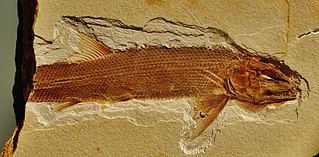
Ophiopsis is an extinct genus of prehistoric ray-finned fish belonging to the family Ophiopsidae. Specimens are known from the Tithonian-age Solnhofen Formation of Bavaria, Germany.
Pleuropholis is an extinct genus of prehistoric ray-finned fish.

Pycnodontidae is an extinct family of ray-finned fishes, ranging from the Jurassic period until the Eocene. It was the largest and most derived family of the successful Mesozoic fish order Pycnodontiformes, and one of only two families to survive into the Cenozoic.

Ohmdenia is an extinct genus of prehistoric bony fish that lived from the Toarcian stage of the Early Jurassic period. Ohmdenia was first described in 1953 by Bernhard Hauff, based on a fossil found in the well-known Posidonia Shale in Holzmaden, Germany. For a long time this animal has been considered a close relative of Birgeria, a great predator typical of the Triassic period with an uncertain systematic position. Further studies have shown similarities with the Pachycormiformes, a group considered close to the origin of teleosts and also including giant forms and planktives. Some studies have erroneously indicated Ohmdenia as a synonym of Saurostomus, other studies have instead placed Ohmdenia as an important evolutionary passage between the basal pachicormiforms and the more derived planktivore pachicormiformes.

Ophiopsiella is an extinct genus of prehistoric ray-finned fish.

















